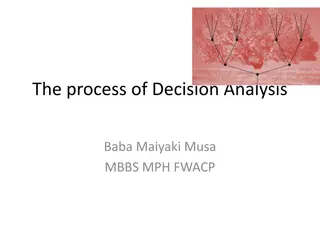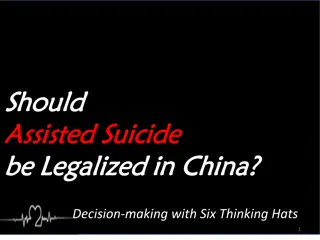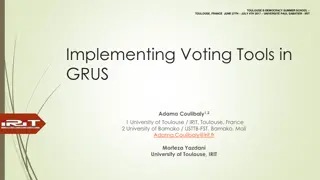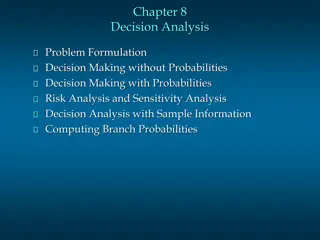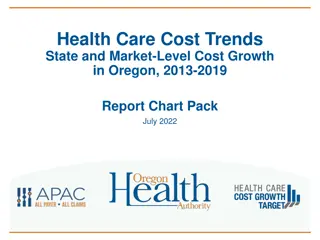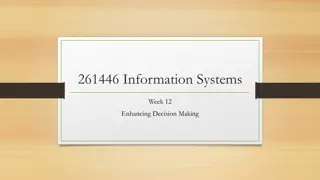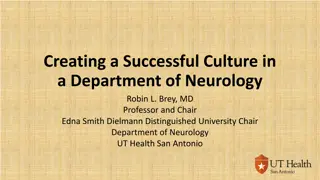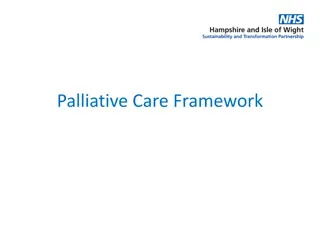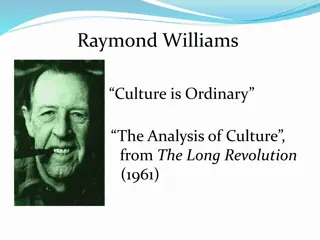
The Culture of Health Care: Processes and Decision Making
Dive into the clinical processes and decision-making involved in health care, exploring classic paradigms, information management, clinical decision making, and more. Understand how clinicians gather and organize information, make diagnoses, and create management plans for patients. Explore a real-world case study of a man presenting with swollen ankles to grasp the complexities of clinical practice.
Download Presentation

Please find below an Image/Link to download the presentation.
The content on the website is provided AS IS for your information and personal use only. It may not be sold, licensed, or shared on other websites without obtaining consent from the author. If you encounter any issues during the download, it is possible that the publisher has removed the file from their server.
You are allowed to download the files provided on this website for personal or commercial use, subject to the condition that they are used lawfully. All files are the property of their respective owners.
The content on the website is provided AS IS for your information and personal use only. It may not be sold, licensed, or shared on other websites without obtaining consent from the author.
E N D
Presentation Transcript
The Culture of Health Care Health Care Processes and Decision Making Lecture b This material (Comp 2 Unit 4) was developed by Oregon Health & Science University, funded by the Department of Health and Human Services, Office of the National Coordinator for Health Information Technology under Award Number IU24OC000015. This material was updated in 2016 by Bellevue College under Award Number 90WT0002. This work is licensed under the Creative Commons Attribution-NonCommercial-ShareAlike 4.0 International License. To view a copy of this license, visit http://creativecommons.org/licenses/by-nc-sa/4.0/.
Health Care Process and Decision Making Learning Objectives Describe the elements of the classic paradigm of the clinical process (Lecture a). List the types of information used by clinicians when they care for patients (Lecture a). Describe the steps required to manage information during the patient-clinician interaction (Lectures a, b, c). List the different information structures or formats used to organize clinical information (Lecture b). Describe different paradigms and elements of clinical decision making. (Lectures a, b) Explain the differences among observations, findings, syndromes, and diseases (Lectures a, b, c). Describe techniques or approaches used by clinicians to reach a diagnosis (Lectures a, b, c, d, e). List the major types of factors that clinicians consider when devising a management plan for a patient s condition in addition to the diagnosis and recommended treatment (Lecture e). Describe the role of EHRs and technology in the clinical decision making-process (lecture a, b, c, d, e). 3
My Ankles Are Swollen Example case: A man who came to the clinic because of ankle swelling. The clinic assistant says, Blood pressure 225 over 140, as she brings in a man with his shoes untied and loosened and with his ankles bulging over the top. He looks healthy enough, but he s a little pale. He says he s a little short of breath after walking in from the parking lot, but his lungs sound clear, and he s only breathing 12 times a minute. Do you smoke? you ask. I used to, he replies, but I quit three years ago. He says he s been gaining weight lately, and his clothes are fitting tight. You check his heart, which has an S4 gallop but no murmur. You ask about his clothes first his shoes, then later his pants, felt too tight. You check his abdomen, which shows no tenderness, masses, or enlarged organs. Then he recalls that he was on medication for blood pressure a few years ago but stopped taking it because he felt slowed down. You check his pulse, which is 120, and on his legs you notice a two- plus pitting to the mid-shin. Have you ever been sick before? you ask. No, never in all my thirty-nine years, except once when I got a rash from aspirin. Oh yeah, and to have my tonsils out, he replies. 4
Clinical Process: The Myth History Physical Assessment Plan The complete history and physical Discrete Linear Orderly Structured 5
Clinical Process: The Reality 4.5 Chart: Depiction of an iterative reasoning clinical process 6
Disease often tells its secrets in a casual parenthesis. -Wilfred Trotter Getting the story o Open-ended questions o Enabling the person to tell his or her story o Including/excluding family, others Filling in the details o Closed-ended questions o Comprehensive checklists, review of systems The tools affect the process Collection Documentation 7
Analyzing Findings - 1 Part 1: Giving Structure to the Data 8
Structured Data Organization Source identification Chief complaint History of present illness Past history Allergies/adverse reactions Medications/treatments Past medical problems Past surgeries Menstrual/obstetric history Immunization/preventive care Family and social history Review of body systems Physical examination Appearance/vitals/skin Head and neck Lungs/heart Abdomen/genitalia Extremities/back Neurologic Ancillary data, diagnostic test results 9
Select the Important Information The clinic assistant says, Blood pressure 225 over 140 (blue), as she brings in a man (blue) whose shoes are untied and loosened, with ankles bulging (blue) over the top. He looks healthy (blue) enough, but a little pale (red). He says he s a little shortof breath after walking (red) in from the parking lot, but his lungs sound clear (blue), and he s only breathing 12 times a minute (blue). Do you smoke (red)? you ask. I used to I quit (red)three years ago. He says he s been gaining weight (red) lately, and his clothes are fitting tight (red). You check his heart, which has an S4 gallop, but no murmur (blue).You ask about his clothes: first his shoes, later his pants (red), felt too tight. You check his abdomen, which shows notenderness, masses, or enlarged organs (blue). Then he recalls he was on medication for blood pressure (red) a few years ago but stopped taking it because he felt slowed down (red). You check his pulse, it s 120 (blue), and on his legs you notice 2+ pitting to mid-shin (blue). Have you ever been sick before? you ask. No, never in all my thirty-nine years, except once when I got a rash from aspirin (red). Oh yeah, and to have my tonsils (red) out. 10
Providing Structure to Data History Physical History of present illness: progressive weight gain; tight shoes, then pants fit tight; exertional dyspnea General: pale, healthy M Vital signs: BP: 225/140; pulse 120; respirations 12 Head and neck negative Allergies: aspirin (rash); hypertension medication ( slowed me down ) Lungs clear Heart: S4 heard, no murmur Patient medical history: hypertension Abdomen nontender; no hepatosplenomegaly Social: quit smoking Extremities: 2+ pitting to mid- shin Surgical history: tonsillectomy 11
Analyzing Findings - 2 Part 2: Finding Patterns and Meaning in the Data 12
Hierarchy for Clinical Data Clinical Data Hierarchy Observations Global complex Syndromes commonly seen together Diseases Specific conditions that cause syndromes Syndromes Constellation of symptoms and signs Facets Groups of findings related by pathophysiology Findings Subset that is relevant to the patient s care Observations (may fit one diagnosis, multiple diagnoses, or no diagnosis) Everything the clinician noticed and noted (the complete history and physical) Empirium Description of clinic, staff, lighting, sound, etc. 4.6 Table: Hierarchy for clinical data (Evans, D.A., and Gadd, C.S., 1989) 13
Man with Edema Clinical Data Hierarchy Observations Global complex None so far Diseases Hypertension? Alcohol? Ischemic heart disease? Toxin? Syndromes Heart failure? Anemia? Facets Weight gain + edema; 225/140 + S4; pallor; tachycardia Weight gain, DOE, Hx HTN, former smoker, pallor, clear lungs, S4, normal abdomen, edema Findings HPI progressive wt gain; shoes, then pants, fit tight; exertional dyspnea; allergy: aspirin (rash); HTN Rx ( slowed me down ); PMH ? HTN on ? Tx SOC quit smoking; SURG tonsillectomy Observations GEN pale; healthy M VS 225/140 120 12 LUNGS clear HEART S4; no M ABD nontender; no HSM EXT 2+ pitting to mid-shin Empirium Clinic environment, staff, distance to parking lot 4.7 Table: Depiction of how the hierarchy for clinical data might work for man with edema, or swelling, of the ankles 14
Creating a Problem List Weight gain + edema Exertional dyspnea but clear lungs Pallor High blood pressure + history of hypertension Tachycardia S4 gallop Risk factors for coronary artery disease Ex-smoker To-Do list for patient care Grouping Group related items Don t group if unsure Include Items that need attention or action Tonsils? Smoking? Male? Expression At level of understanding but no more Problems with persistence, precision of coding 15
Health Care Processes and Decision Making Summary Lecture b Information gathering and processing were examined The structure of the history and physical were discussed and correlated to a hierarchy Through the context of a case study, the levels of the hierarchy were examined 16
Health Care Processes and Decision Making References Lecture b References Croskerry, P. (2013) From Mindless to Mindful Practice Cognitive Bias and Clinical Decision Making. New England Journal of Medicine 368:2445-2448 June 27. Elstein, A. S., & Schwartz, A. (2002) Clinical problem solving and diagnostic decision making: Selective review of the cognitive literature. BMJ 324 (7339):729 732. Retrieved from http://www.bmj.com/content/324/7339/729 Evans, D. A., & Gadd, C. S. (1989). Managing coherence and context in medical problem-solving discourse. In Evans DA, Patel V. L. (Eds.), Cognitive science in medicine: Biomedical modeling. Cambridge, MA: MIT Press; 211 255. Kannampallil, T. G., Jones, L. K., Patel, V. L., Buchman, T. G., & Franklin, A. (2014). Comparing the information seeking strategies of residents, nurse practitioners, and physician assistants in critical care settings. Journal of the American Medical Informatics Association 21 (2): e-249 e256. Retrieved from http://jamia.oxfordjournals.org/content/21/e2/e249 Trotter, W. (n.d.) Quotation. Disease often tells its secrets in a casual parenthesis. 17
Health Care Processes and Decision Making References Lecture b Continued Charts, Tables 4.5 Chart: Depiction of an iterative reasoning clinical process 4.6 Table: Hierarchy for clinical data. Evans, D. A., & Gadd, C. S. (1989). Managing coherence and context in medical problem-solving discourse. In Evans DA, Patel V. L. (Eds.), Cognitive science in medicine: Biomedical modeling. Cambridge, MA: MIT Press; 211 255. 4.7 Table: Depiction of how the hierarchy for clinical data might work for man with edema, or swelling, of the ankles 18
The Culture of Health Care Health Care Processes and Decision Making Lecture b This material was developed by Oregon Health & Science University, funded by the Department of Health and Human Services, Office of the National Coordinator for Health Information Technology under Award Number IU24OC000015. This material was updated in 2016 by Bellevue College under Award Number 90WT0002. 19





